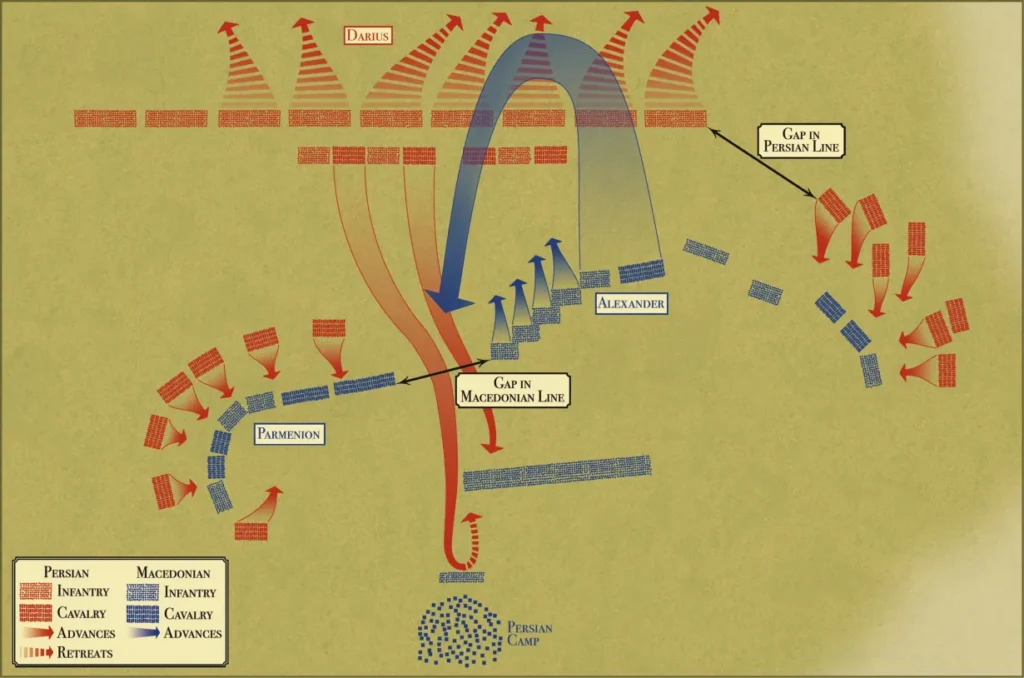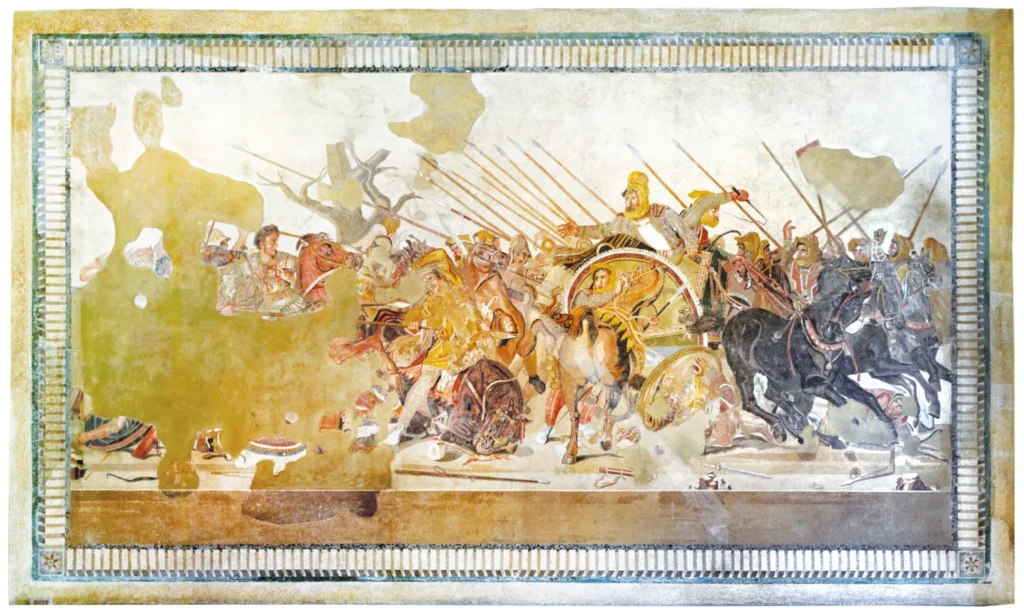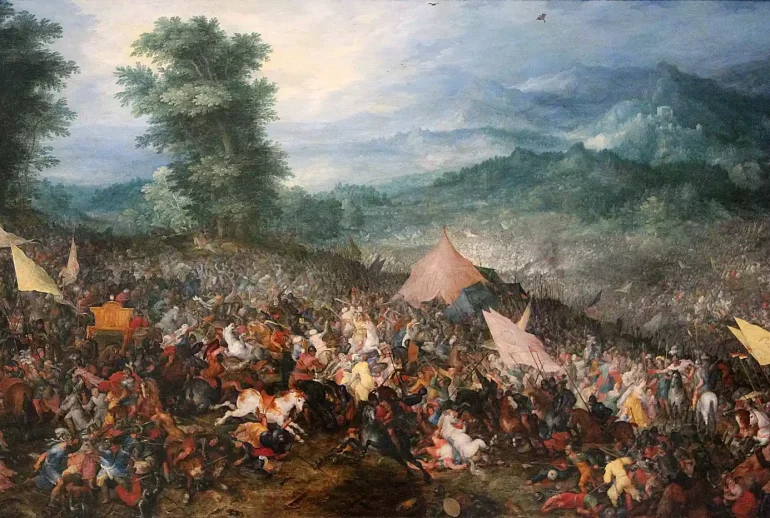Last night, just as I was about to close Phillip Freeman’s biography on Alexander to get to sleep (listening to my body, a must in your forties), I came across the section about Alexander’s preparation for the Battle of Gaugamela and couldn’t help but connect it to many planning sessions I’ve been in at various startups. I know, I know – it’s taken my wife 20 years to be able to listen to me wax on about historical trivia, and I’m sure she’s very happy that I’m blogging again.
On the morning of his most pivotal battle, a contest against Darius III that would decide the Persian Empire’s fate and Alexander’s claim to mortal or immortal glory, the 25-year-old king slept in.
The confidence with a good strategy
Alexander had struggled with sleep the night before. The circumstances were dire. Alexander’s 47,000 troops were vastly outnumbered by the Darius’ 150,000 men. The Persians had chosen the battlefield, a vast plain that favored their large army and left no hiding places for the Greek’s smaller forces to deploy surprise or rearguard attacks. Finally, the Persians had arrived first and were well rested and ready. Alexander’s troops had just made camp a few days prior.
No wonder Alexander couldn’t sleep until he had a working strategy for an immense problem: how to defeat a force far superior is size and resources.
When Alexander's officers arrived at sunrise the next morning [on the day of the battle], they couldn't believe the king was still in bed... Finally, with the sun rising in the east, Parmenion at last entered Alexander's tent and called to him loudly two or three times before the king opened his eyes. The indignant old general asked how he could be sleeping so soundly as if he had gained a victory when the battle was still ahead. Alexander only smiled and said, "Why, don't you know we've already won?"
Alexander the Great, Phillip Freeman
Alexander’s confidence came from a strategy that leveraged three steps:
- He identified the core problems based on multiple frames of references
- He maximized his strengths while minimizing his enemy’s strength
- He acted with purpose at the right moment
Understanding the Situation
Alexander’s strategy was informed by a blend of scholarly study, personal experience, and timely intelligence on his opponents. He also was intimately aware of his troops and their strengths.
Alexander was an avid reader. His two favorite books were the Illiad and Anabasis, which he carried everywhere. Anabasis, written by Xephonon, a Greek solider, offered historical insights into Persian military strategies and formations a century before Alexander’s campaigns in Asia. From an early age, Alexander was obsessed by Xephonon’s observations at how the Persians organized their armies and how they fought.
He corroborated his theoretical understanding with firsthand lessons. Notably, at the Battle of Issus, two years prior, he gained valuable observations on how Darius reacted to his forces’ maneuvers.
And on the day before the battle, he went to scout Darius’ army personally, underlining his direct approach to gathering intelligence.
The king took a squadron of cavalry and light-armed troops down into the plain to see the battlefield for himself. It was risky to draw so close to the Persian archers, but Alexander was determined to examine the ground his men would be fighting on the next day.
Alexander the Great, Phillip Freeman
Maximize Your Strengths and Minimize Opponent's Weakenss
Despite being significantly outnumbered, Alexander’s troops were agile, highly trained, and battle-hardened. Their cavalry, recognized as the finest in the world, had endured numerous campaigns across Thrace, Asia Minor, and the Levant. As they marched from Greece to Mesopotamia, his infantry sharpened their skills and discipline, mastering tactics to counter Persian maneuvers effectively.
Alexander used his cavalry’s speed as the core of his strategy. The only way to win was to cut a path through the Persian’s front line, throw them off balance, and create chaos to disperse the numerical advantage.
First, he deployed a small number of shock troops to attack and harass the Persians on their right flank. Then, in a daring move, Alexander then executed a masterful maneuver with his horsemen:
He [tried] something no other general in history had ever done. He now set out with his calvary force on the right of his line not toward the Persians but parallel to their forces, riding farther and farther to the right of the battlefield without ever coming into contact with the enemy. This must have seemed ridiculous to Darius, as if [Alexander] were hoping to circle around his superior forces.
Alexander the Great, Phillip Freeman
Alexander gambled on the Persians redistributing their forces to chase his decoys, requiring a swift cavalry charge. This was risky, as his main army faced the Persian onslaught while attempting to draw away part of their front line. Failure to hold against the Persians meant Alexander would need to abandon the feint to protect his troops.
His bet was based on crucial insights:
- Parmenion’s troops were trained to endure the Persian assault.
- Darius was unlikely to commit his entire army, including cavalry, elephants, infantry, and archers, at once, preferring staggered attacks.
- Alexander’s cavalry could quickly withdraw if necessary.

Here’s what happened.
The Persian plan was to use the scythed chariots - deadly vehicles with blades attached to their wheels... What Darius didn't realize was that Alexander had been drilling his men for weeks on how to face these terrifying machines.
Alexander the Great, Phillip Freeman
The Persians counted on their charioteers and cavalry for an edge, mistakenly valuing equipment over their size advantage. This strategy failed. Armed with long javelins, Alexander’s Macedonians, Greeks, and Thracians overcame the Persian chariots, even pulling drivers down by seizing the reins. This remarkable victory underscored the importance of preparation, training, and understanding the enemy.
Purposeful Action
As Alexander’s troops held the line, the Persians reacted to Alexander’s crazy gambit and gave chase to his calvary. Perhaps they thought that the young king might be able to circle behind them with his fast horses. Perhaps they panicked. As a result, the middle of the Persian front lines opened up and Alexander saw the opening. He swept back around, galloping on his legendary horse Bucephalus straight towards the terrified Darius.
With a loud battle cry, Alexander and his men flew toward the Great King and charged into the Persian lines. Darius had not dreamed that Alexander would be able to break through... but now he saw the young Macedonian king fighting his way through spears and swords to get to him. It was a brutal struggle on both sides.. but at last... the Great King ordered his charioteer to turn and flee the battlefield.
Alexander, Phillip Freeman
This is epic stuff. His strategy vindicated, Alexander now is ruler of the largest Empire on Earth and well on his way towards reshaping how the world thinks, interacts and behaves for the next millennia.
Startup Lessons
Like Alexander at Gaugamela, startups navigate overwhelming challenges, relying on smarts and speed over sheer force to outmaneuver larger, more resourceful competitors. Yet, many overlook the importance of a solid strategy, opting instead for action as a veneer of progress.
For example, many founders adopt the “move fast” ethos as a knee-jerk response to setbacks such as low customer retention, high customer acquisition costs, or ineffective processes and research. The urge to accelerate and increase output often masks these issues without addressing the underlying problems.
Move with insights
Alexander moved fast, but his speed was purposeful and based on key insights. He made high-risk bets on those insights: his well trained and equipped troops can hold the line while his fast cavalry can create an opening for attack.

A lot of startups don’t purposefully define their strengths. Without this, they can’t deploy a strategy to create leverage. Leverage simply means “using resources to their maximum advantage”. My favorite book on strategy Good Strategy Bad Strategy summarizes leverage well:
A good strategy draws power from focusing minds, energy, and action. That focus, channeled at the right moment onto a pivotal objective, can produce a cascade of favorable outcomes. I call this source of power leverage.
Good Strategy Bad Strategy: the Difference and Why It Matters, Richard Rumelt
Not all strategies work. But not having a clear strategy before deploying your employees, money and efforts is a recipe for disaster. And strategies need to be based on actionable insights that a team can leverage. Alexander had to dig deep and executed a risky strategy that no general before him had done before. He won, and so we read books about him and try to get lessons from his exploits. If he had lost, no one would be discussing his tactics a thousand years later.
Peace of Mind
How important is a good strategy to success? From Alexander’s example, I think that it was the combination of his strategy, execution, and not a little luck that he was victorious at Gaugama. At the very least, with a good strategy, he was able to get a good night’s sleep.
